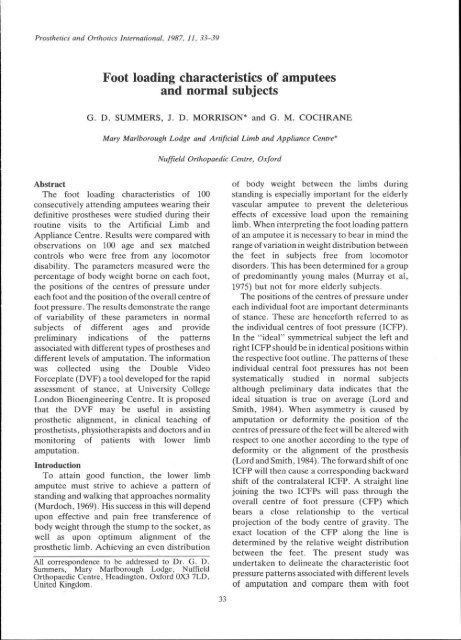View Complete Issue PDF
View Complete Issue PDF
View Complete Issue PDF
You also want an ePaper? Increase the reach of your titles
YUMPU automatically turns print PDFs into web optimized ePapers that Google loves.
Prosthetics and Orthotics International, 1987, 11, 33-39<br />
Foot loading characteristics of amputees<br />
and normal subjects<br />
G. D. SUMMERS, J. D. MORRISON* and G. M. COCHRANE<br />
Mary Marlborough Lodge and Artificial Limb and Appliance Centre*<br />
Nuffield Orthopaedic Centre, Oxford<br />
Abstract<br />
The foot loading characteristics of 100<br />
consecutively attending amputees wearing their<br />
definitive prostheses were studied during their<br />
routine visits to the Artificial Limb and<br />
Appliance Centre. Results were compared with<br />
observations on 100 age and sex matched<br />
controls who were free from any locomotor<br />
disability. The parameters measured were the<br />
percentage of body weight borne on each foot,<br />
the positions of the centres of pressure under<br />
each foot and the position of the overall centre of<br />
foot pressure. The results demonstrate the range<br />
of variability of these parameters in normal<br />
subjects of different ages and provide<br />
preliminary indications of the patterns<br />
associated with different types of prostheses and<br />
different levels of amputation. The information<br />
was collected using the Double Video<br />
Forceplate (DVF) a tool developed for the rapid<br />
assessment of stance, at University College<br />
London Bioengineering Centre. It is proposed<br />
that the DVF may be useful in assisting<br />
prosthetic alignment, in clinical teaching of<br />
prosthetists, physiotherapists and doctors and in<br />
monitoring of patients with lower limb<br />
amputation.<br />
Introduction<br />
To attain good function, the lower limb<br />
amputee must strive to achieve a pattern of<br />
standing and walking that approaches normality<br />
(Murdoch, 1969). His success in this will depend<br />
upon effective and pain free transference of<br />
body weight through the stump to the socket, as<br />
well as upon optimum alignment of the<br />
prosthetic limb. Achieving an even distribution<br />
of body weight between the limbs during<br />
standing is especially important for the elderly<br />
vascular amputee to prevent the deleterious<br />
effects of excessive load upon the remaining<br />
limb. When interpreting the foot loading pattern<br />
of an amputee it is necessary to bear in mind the<br />
range of variation in weight distribution between<br />
the feet in subjects free from locomotor<br />
disorders. This has been determined for a group<br />
of predominantly young males (Murray et al,<br />
1975) but not for more elderly subjects.<br />
The positions of the centres of pressure under<br />
each individual foot are important determinants<br />
of stance. These are henceforth referred to as<br />
the individual centres of foot pressure (ICFP).<br />
In the "ideal" symmetrical subject the left and<br />
right ICFP should be in identical positions within<br />
the respective foot outline. The patterns of these<br />
individual central foot pressures has not been<br />
systematically studied in normal subjects<br />
although preliminary data indicates that the<br />
ideal situation is true on average (Lord and<br />
Smith, 1984). When asymmetry is caused by<br />
amputation or deformity the position of the<br />
centres of pressure of the feet will be altered with<br />
respect to one another according to the type of<br />
deformity or the alignment of the prosthesis<br />
(Lord and Smith, 1984). The forward shift of one<br />
ICFP will then cause a corresponding backward<br />
shift of the contralateral ICFP. A straight line<br />
joining the two ICFPs will pass through the<br />
overall centre of foot pressure (CFP) which<br />
bears a close relationship to the vertical<br />
projection of the body centre of gravity. The<br />
exact location of the CFP along the line is<br />
determined by the relative weight distribution<br />
between the feet. The present study was<br />
undertaken to delineate the characteristic foot<br />
pressure patterns associated with different levels<br />
of amputation and compare them with foot<br />
33
















